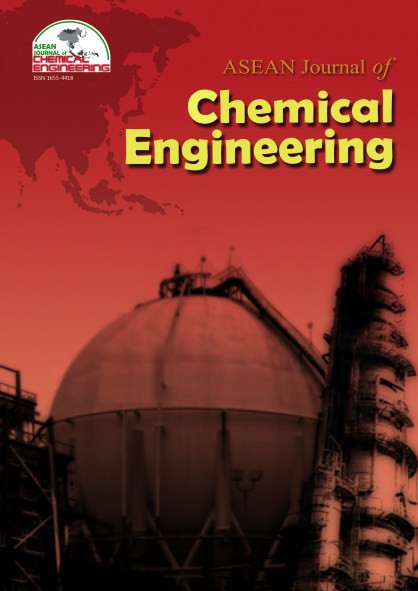Characterization of Titania (TiO2) Catalysts Prepared by Sol-Gel Method
Abstract
Various TiO2 catalysts in powder form were prepared ny sol-gel method and then characterized for X-ray diffraction and BET surface area. VAriation in composistion of reactants, choice of hydrolysing catalyst, calcination temperature, and method of drying were among preparative variable evaluated. Addition Pt, Fe2O3, CuO and SiO2 on the catalysts was also carried out during the initial stage of sol formation. XRD analysis suggest that all catalysts calcined at 450'C were compeltelu in anatase phase. BET surface area of the catalysts revealed that the catalysts prepared using HNO3 as hydrolysing catalyst, have a surface area larger than the commercial Degussa P25 TiO2 catalyst, with the highest area of 126m2/g. The addition of metals resulted in a lower surface area, while silica provided a considerable incdease in surface area, at 257 m2/g. Analyses of isotherms plot and BJH desorption plots suggest that particle pores were dominated by a bottle-like share. However, the photocalatylstic activity of these catalysts in te degradation of sufactant failed to meet the perfomance rating of Degussa P23 TiO2 catalyst, probably due to less access of surfactant into interbal surface of the prepared catalysts. Degradation of the surfactant usidng different particle sizes suggests that the external surface of TiO2 catalysts was important under liquid phase degradation.References
Brinker, C.J. and Scherer, G.W. "Sol-Gel Science The Physics and Chemistry of Sol-Gel Processing", Academic Press, Tokyo (1995).
Fan, Q., McQuillin, B., Ray, A.K., Turner M.L., and Seddon, A.B., High Density Non-porous Anatase Thin Films for Device Applications, J. Phys. D: Appl. Phys., 2000, Vol. 33, pp. 2683-2686.
Fotou, G.P., Vemury, S. and Pratsinis, S.E., Synthesis and Evaluation of Titania Powders for Photodestruction of Phenol, Chem. Eng. Sci., 1994, Vol. 49 No. 24B pp. 4939-4948.
Guillard, C., Beaugiraud, B., Dutriez, C.,Herrmann, J.M., Jaffrezic, H., Jaffrezic-Renault, N., and Lacroix, M , Physicochemical Properties and Photocatalytic Activities of Ti0,-Films Prepared by Sol-Gel Methods, Appl. Catal. B: Environ., 2002, No. 39, pp. 331-342.
Igwe, G.J.I., "Powder Technology and Multiphase Systems : Gas Permeametry and Surface Area Measurement", Ellis Harwood, New York (1995).
Kajihara, K., Nakanishi, K., Tanaka, K.,Hirao, K., and Soga, N., Preparation of Macroporous Titania Films by a Sol Gel Dip-Coating Method from the System Containing Poly(ethylene glycol), J. Am. Ceram. Soc., 1998, Vol. 81, No. 10, pp. 2670-2676.
Lee, C.K.,Effect of Heating on the Surface Roughness and Pore Connectivity of TiO,Fractal and Percolation Analysis, J. Chem. Eng. Japan, 2001, Vol. 34, No. 6, pp. 724-730.
Suzuki, Y., Maezawa, A. and Uchida S.,Utilization of Ultrasonic Energy in a Photocatalytic Oxidation Process for Treating Wastewater Containing Surfactants, Japan J. Appl. Phys., 2000, Vol. 39, pp. 2958-2961
Thomas, J.M. and Lambert, R.M., “Characterization of Catalysts", John Wiley & Sons, Chichester (1990).
Wang, C.C. and Ying, J.Y., Sol-Gel Synthesis and Hydrothermal Processing of Anatase and Rutile Titania Nanocrystal, Chem Mater., 1999, Vol. 11, pp. 3113-3120.
Xu, N., Shi, Z., Fan, Y., Dong, J., Shi, J. and Hu, M.2.C., Effect of Particle Size of Tio, on Photocatalytic Degradation of Methylene Blue in Aqueous Suspensions Ind. Eng. Chem. Rev., 1999, Vol. 38, pp. 373-379.
Copyright holder for articles is ASEAN Journal of Chemical Engineering. Articles published in ASEAN J. Chem. Eng. are distributed under a Creative Commons Attribution-NonCommercial 4.0 International (CC BY-NC 4.0) license.
Authors agree to transfer all copyright rights in and to the above work to the ASEAN Journal of Chemical Engineering Editorial Board so that the Editorial Board shall have the right to publish the work for non-profit use in any media or form. In return, authors retain: (1) all proprietary rights other than copyright; (2) re-use of all or part of the above paper in their other work; (3) right to reproduce or authorize others to reproduce the above paper for authors’ personal use or for company use if the source and the journal copyright notice is indicated, and if the reproduction is not made for the purpose of sale.



